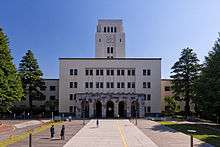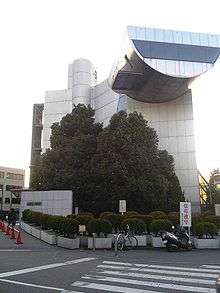Tokyo Institute of Technology
Tokyo Institute of Technology (東京工業大学, Tōkyō Kōgyō Daigaku, informally Tokyo Tech, Tokodai or TIT) is a national research university located in Greater Tokyo Area, Japan. Tokyo Tech is the largest institution for higher education in Japan dedicated to science and technology, and is generally considered to be one of the most prestigious universities in Japan.
東京工業大学 | |
 | |
| Motto | Jidai wo tsukuru chi, waza, kokorozashi, wa no rikōjin (時代を創る知・技・志・和の理工人) |
|---|---|
Motto in English | Engineers of the Knowledge, Technology and Passion that Change our World. |
| Type | Public (National) |
| Established | 1881 |
| President | Dr. Kazuya Masu |
Academic staff | 1,324 |
| Undergraduates | 4,940 |
| Postgraduates | 5,096 |
| Location | , Tokyo Kanagawa , Japan |
| Campus | Urban/rural |
| Colours | Royal Blue (DIC-641) |
| Mascot | None |
| Website | http://www.titech.ac.jp/ |
Tokyo Tech's main campus is located at Ōokayama on the boundary of Meguro and Ota, with its main entrance facing the Ōokayama Station. Other campuses are located in Suzukakedai and Tamachi. Tokyo Tech is organised into 6 schools, within which there are over 40 departments and research centres.[1] Tokyo Tech enrolled 4,734 undergraduates and 1,464 graduate students for 2015–2016.[2] It employs around 1,100 faculty members. Tokyo Institute of Technology produced a Nobel Prize laureate in Chemistry Hideki Shirakawa Ph.D.
History
Foundation and early years (1881–1922)
Tokyo Institute of Technology was founded by the government of Japan as the Tokyo Vocational School on May 26, 1881,[3] 14 years after the Meiji Restoration. To accomplish the quick catch-up to the West, the government expected this school to cultivate new modernized craftsmen and engineers. In 1890, it was renamed Tokyo Technical School. In 1901, it changed name to Tokyo Higher Technical School.
Great Kantō earthquake and World War II (1923–1945)
In early days, the school was located in Kuramae, the eastern area of the Greater Tokyo Area, where many craftsmens' workshops had been since the old Shōgun's era. The buildings in Kuramae campus were destroyed by the Great Kantō earthquake in 1923. In the following year, the Tokyo Higher Technical School moved from Kuramae to the present site in Ookayama, a south suburb of the Greater Tokyo Area. In 1929 the school became Tokyo Institute of Technology, gaining a status of national university, which allowed the university to award degrees. The university had the Research Laboratory of Building Materials in 1934, and its five years later the Research Laboratory of Resources Utilisation and the Research Laboratory of Precision Machinery were constructed. The Research Laboratory of Ceramic Industry was made in 1943, and one year before the World War Two finished the Research Laboratory of Fuel Science and the Research Laboratory of Electronics were made.
Post-War Era (1946–present)
After World War II, the new education system was promulgated in 1949 with the National School Establishment Law, and Tokyo Institute of Technology was reorganized. Many three-year courses were turned into four-year courses with the start of the School of Engineering this year. The university started graduate programmes in engineering in 1953. In the following year, the five research laboratories were integrated and reorganised into four new labs: the Research Laboratory of Building Materials, the Research Laboratory of Resources Utilization, the Precision and Intelligence Laboratory and the Research Laboratory of Ceramic Industry, and the School of Engineering was renamed the School of Science and Engineering.
Throughout the post-war reconstruction of the 1950s, the high economic growth era of the 1960s, and the aggressive economic era marching to the Bubble Economy of the 1980s, TIT kept providing Japan its leading engineers, researchers, and business persons. Since April 2004, it has been semi-privatized into the National University Incorporation of Tokyo Institute of Technology under a new law[4] which applied to all national universities.
Operating the world-class supercomputer Tsubame 2.0,[5] and making a breakthrough in high-temperature superconductivity, Tokyo Tech is a major centre for supercomputing technology and condensed matter research in the world.
In 2011, it celebrated the 130th anniversary of its founding.[6] In 2014, it joined the edX consortium and formed the Online Education Development Office (OEDO) [7] to create MOOCS, which are hosted on the edX website.[8]
In its 130 years, Tokyo Tech has provided scientific researchers and engineers and many social leaders, including Naoto Kan who is a former prime minister.
Campuses

Tokyo Tech has three campuses, the Ōokayama campus in Ōokayama Meguro as the main campus, Tamachi campus in Shibaura and the Suzukakedai campus, located in Nagatsuta, Midori-ku in Yokohama.
- Ōokayama Station campus
- Tamachi campus
- Suzukakedai campus
Organization
The university is currently undergoing an educational reform and schools and departments are being reorganized.
Undergraduate schools

- School of Science
- School of Engineering
- School of Bioscience and Biotechnology
Graduate schools
- Graduate School of Science and Engineering
- Graduate School of Bioscience and Biotechnology
- Interdisciplinary Graduate School of Science and Engineering
- Graduate School of Information Science and Engineering
- Graduate School of Decision Science and Technology
- Graduate School of Innovation Management
Research laboratories
- Chemical Resources Laboratory
- Precision and Intelligence Laboratory
- Materials and Structures Laboratory
- Research Laboratory for Nuclear Reactors
- Quantum Nano Electronics Research Centre[9]
- Earth-Life Science Institute (ELSI)
Politics and social sciences
- Centre for Research in Advanced Financial Technology (Tokyo Institute of Technology)
- Precision and Intelligence Laboratory (Tokyo Institute of Technology)
- Solutions Research Laboratory
- Integrated Research Institute
- Global Edge Institute (Tokyo Institute of Technology)
- Productive Leader Incubation Platform
- Academy for Global Leadership
- Centre for Research and Development of Educational Technology (Tokyo Institute of Technology)
- Research Centre for Educational Facilities
- Creative Research Laboratory
- Research Centre for the Science of Institutional Management of Technology
- Collaboration Centre for Design and Manufacturing (CODAMA)
- Centre for Agent-Based Social Systems Sciences (Tokyo Institute of Technology)
- Foreign Language Research and Teaching Centre
- Centre for the Study of World Civilisations
- Asia-Africa Biology Research Centre
- Centre for CompView Research and Education
- Career Advancement Professional School
- Organization for Life Design and Engineering
- Centre for Liberal Arts
Engineering and computing
- Materials and Structure Laboratory (Tokyo Institute of Technology)
- Frontier Research Centre
- Imaging Science and Engineering Laboratory
- Global Scientific Information and Computing Centre
- Structural Engineering Research Centre
- Super-Mechano Systems R&D Centre
- Centre for Photonic Nano-Device Integrated Engineering
- Photovoltaics Research Center
- Inter-departmental organisation for Informatics
Chemistry and life sciences
- Chemical Resources Laboratory
- Research Centre for Carbon Recycling and Energy
- Centre for Biologial Resources and Informatics
- International Research Centre of Macromolecular Science
- Bio-Frontier Research Centre
- Emerging Nanomaterial Research Centre
- Centre for Molecular Science and Technology
- The Osmotic Power Research Centre
Physics and astronomy
- Volcanic Fluid Research Centre (Tokyo Institute of Technology)
- Research Laboratory for Nuclear Reactors (Tokyo Institute of Technology)
- Research Centre for Low Temperature Physics
- Quantum Nanoelectronics Research Centre
- Centre for Urban Earthquake Engineering
- Research Centre for Nanometer-Scale Quantum Physics
- Research Centre for the Evolving Earth and Planets
- Centre for Research into Innovative Nuclear Energy Systems
Other facilities
- Asia-Oceania Top University League on Engineering
- Tokyo Tech Archive Initiative
- Health Service Centres
- TITECH Earth Database Centre
- Tokyo Tech Front
- International Student Centre
- Inter-departmental Organization for Environment and Energy
- ICE Cube Centre
Academics
Libraries
The main library of Tokyo Tech is the Tokyo Institute of Technology Library in Ookayama. It is the home of Japan's largest science and technology library. The library was founded in 1882,[10] and it lost nearly 28,000 books during the Great Kantō earthquake in 1923. Moved to Ookayama in 1936, it has been the national science and technology library of Japan.
1,200 students and staff visit the library each day.
It has 674,000 books and 2,500 journals, including 1,600 foreign academic journals; the number of international research collections is the largest in Japan. It provides around 7,000 registered electronic journals each year. The library is therefore recognised for the outstanding national and international importance and awarded 'Centre of foreign journals' by the government of Japan. Renewal construction of the library was completed on July 2011.
International graduate programmes
Tokyo Tech runs intensive programmes for obtaining master degree or PhD. Called the Tokyo Tech's International Graduate Program, the programmes are targeted at international students of high academic potential who are not Japanese speakers. Lectures and seminars are given in English mainly by Tokyo Tech's faculty members.[11] Programme starting dates are October or April. Public fundings for these courses are also available; those students who have academic excellence may apply for scholarships from the Ministry of Education, Culture, Sports, Science and Technology of Japan.
Rankings
| Kawaijuku National[12] | General | 4 |
|---|---|---|
| WE National[13] | Employment | 2 |
| NBP Greater Tokyo[14][15] | Reputation | 6 |
| QS Asia (Asian Ranking version)[16] | General | 9 |
| ARWU Asia[17] | Research | 10–18 |
| THE World[18] | General | 112 |
| QS World[19] | General | 57 |
| ARWU World[17] | Research | 101–150 |
| ENSMP World[20] | Alumni | 92 |
| Natural Sciences & Technology | ||
|---|---|---|
| Engineering | ||
| Kawaijuku National[21] | General | 2~3 |
| QS World[22] | General | 19 |
| MATERIALS SCIENCE | ||
| T.Reuters National[23] | Research | 5 |
| T.Reuters World[23] | Research | 24 |
| PHYSICS | ||
| T.Reuters National[23] | Research | 5 |
| T.Reuters World[23] | Research | 31 |
| CHEMISTRY | ||
| T.Reuters National[23] | Research | 5 |
| T.Reuters World[23] | Research | 22 |
| MATHEMATICS | ||
| ARWU National[24] | Research | 3 |
| ARWU World[24] | Research | 77–100 |
| ARCHITECTURE | ||
| ARE Success National[25] | Qualification | 23 |
| * T. Reuters World rankings include non-educational institutions | ||
Tokyo Tech is one of the most prestigious universities in Japan. It can be seen in the several rankings such as shown below.
General rankings
The university has been ranked 2nd(National) in 2011 in the field of Engineering "Entrance score ranking of Japanese universities-Department of Engineering" by Score-navi.[26] In another ranking, Japanese prep school Kawaijuku ranked Tokyo Tech as the 4th best(overall), 2-3rd best in former semester and 1st in latter semester (Department of Engineering) university in Japan (2012).[27]
According to QS World University Rankings, Tokyo Tech was ranked 3rd in Japan and internationally ranked 20th in the field of Engineering and Technology, and 51st in Natural science in 2011.[28] The university was ranked 31st worldwide according to Global University ranking[29] and 57th in 2011 according to QS World University Rankings,[30] It was also ranked 31st worldwide according to the Global University Ranking in 2009.[29]
Research performance
Tokyo Tech is one of the top research institutions in natural sciences and technology in Japan. According to Thomson Reuters, its research excellence (Pure science only for this information) is especially distinctive in Materials Science (5th in Japan, 24th in the world), Physics (5th in Japan, 31st in the world), and Chemistry (5th in Japan, 22nd in the world).[31]
Weekly Diamond also reported that Tokyo Tech has the highest research standard in Japan in terms of research fundings per researchers in COE Program.[32] In the same article, it's also ranked 8th in terms of the quality of education by GP funds per student.
In addition, according to the September 2012 survey by QS World University Rankings about the general standards in Engineering and Technology field, Tokyo Tech was placed 19th (world), 2nd (national).[33]
The Tsubame 2.0, which is a large-scale supercomputer in Tokyo Tech, was ranked 5th of the world best-performed computer. 1st in the world as university's owned one, this supercomputer is used for simulation related to the complex systems such as the dynamics of planets or financial systems.
As Tokyo Tech has been emphasizing on 'practical' research, Tokyo Tech got the 2nd place at the number of patents accepted (284) during 2009 among Japanese Universities.[34]
Alumni rankings
Alumni of Tokyo Tech enjoy their good success in Japanese industries. According to the Weekly Economist's 2010 rankings and the PRESIDENT's article on 2006/10/16, graduates from Tokyo Tech have the 2nd best employment rate in 400 major companies, and the average graduate salary is the 9th best in Japan.[35][36] École des Mines de Paris ranks Tokyo Tech as 92nd in the world in 2011 in terms of the number of alumni listed among CEOs in the 500 largest worldwide companies.[37] Also, according to the article of The New York Times- Universities with the most employable students ranking 2012, Tokyo Tech ranked 14th place in the world (2nd in Asia, 1st in Japan).[38]
Wildlife
As of 2009 there is a large population of rose-ringed parakeets residing at the main campus of the Tokyo Institute of Technology in Ookayama.[41][42][43]
Gallery
 Suzukakedai campus at night
Suzukakedai campus at night Suzukakedai campus at night
Suzukakedai campus at night Suzukakedai campus at night
Suzukakedai campus at night
Alumni and faculty
See also
- Ken Mogi
- Research Institutes at Tokyo Tech[44]
- Supercomputing in Japan
References
- the number of undergraduates and departments of Tokyo Tech Archived September 29, 2011, at the Wayback Machine facts and stats
- Data Book 2015-2016, by the TIT
- "The history of the Tokyo Institute of Technology" http://www.titech.ac.jp/english/about/overview/history.html
- Archived December 5, 2004, at the Wayback Machine
- Japan reclaims no.1 spot on TOP500 list of world's fastest supercomputers Archived July 1, 2012, at Archive.today International Business Times
- "Tokyo Institute of Technology – The 130th Anniversary". 130th.titech.ac.jp. Retrieved November 26, 2011.
- "Tokyo Tech Online Education Development Office" https://www.facebook.com/oedotitech
- "Tokyo Institute of Technology Joins edX MOOCs Consortium founded by MIT and Harvard University," http://www.titech.ac.jp/english/news/2014/029068.html
- "Welcome to QNERC". Pe.titech.ac.jp. Retrieved November 26, 2011.
- "Archived copy". Archived from the original on July 10, 2011. Retrieved July 18, 2011.CS1 maint: archived copy as title (link) About us, Tokyo Institute of Technology Library
- "Prospectus for International Students". Gakumu.titech.ac.jp. Archived from the original on November 26, 2011. Retrieved November 26, 2011.
- "Kawai 30 Top Japanese Universities". Kawaijuku. 2001. Retrieved April 29, 2011.
- "Employment rate in 400 major companies rankings" (in Japanese). Weekly Economist. 2011. Retrieved April 29, 2011.
- "Nikkei BP Brand rankings of Japanese universities" (in Japanese). Nikkei Business Publications. 2010. Retrieved April 29, 2011.
- "Nikkei BP Brand rankings of Japanese universities" (in Japanese). Nikkei Business Publications. 2009. Retrieved April 29, 2011.
- "QS Asian University Rankings". QS Quacquarelli Symonds Limited. 2016. Retrieved September 24, 2017.
- "Academic Ranking of World Universities". Institute of Higher Education, Shanghai Jiao Tong University. 2017. Retrieved September 24, 2017.
- "THE World University Rankings". Times Higher Education. 2018. Retrieved September 24, 2017.
- "QS World University Rankings". QS Quacquarelli Symonds Limited. 2018. Retrieved September 24, 2017.
- "ENSMP World University Rankings" (PDF). École nationale supérieure des mines de Paris. 2011. Retrieved April 29, 2011.
- "Kawaijuku japanese universities rankings in Engineering field" (in Japanese). Kawaijuku. 2012. Retrieved July 20, 2012.
- "QS topuniversities world rankings in Engineering field". Topuniversities. 2012. Retrieved July 20, 2012.
- "Thomson Reuters 10 Top research institutions by subject in Japan" (in Japanese). Thomson Reuters. 2010. Retrieved May 11, 2011.
- "ARWU in Mathematics". Shanghai Jiaotong University. 2011. Retrieved May 11, 2011.
- "Architects Registration Exam Successful Applicants rankings" (in Japanese). Shikaku Seek. 2010. Retrieved May 11, 2011.
- "score navi rankings by field". Archived from the original on October 11, 2012. Retrieved August 20, 2012.
- "Kawaijuku- 2013 rank preview" (PDF).
- "QS Topuniversities in – 2011". Topuniversities.com. Retrieved June 26, 2012.
- "globaluniversitiesranking.org" (PDF). globaluniversitiesranking.org. Archived from the original (PDF) on August 27, 2011. Retrieved November 26, 2011.
- "QS World University Rankings". Topuniversities. Archived from the original on September 30, 2011. Retrieved November 26, 2011.
- "Thomson Reuters 20 Top research institutions in Japan" (in Japanese). Thomson Reuters. Archived from the original on June 13, 2011. (this raking includes non-educational institutions)
- "週刊ダイヤモンド" ダイヤモンド社 2010/2/27 http://web.sapmed.ac.jp/kikaku/infomation/0227daiyamondokiji.pdf
- "QS world university ranking(2012)". topuniversities.com. Retrieved September 18, 2012.
- (in Japanese) 2009 年国内大学別特許公開件数, Japanese patent office, accessed May 3, 2011
- "Employment rate in 400 major companies rankings" (in Japanese). Weekly Economist. 2011. Retrieved April 29, 2011.
- 大学偏差値情報局 (February 22, 1999). "年収偏差値・給料偏差値ランキング(2006・10・16):稼げる大学はどれ?". Hensachi-ranking.seesaa.net. Retrieved November 26, 2011.
- "Archived copy" (PDF). Archived from the original (PDF) on July 20, 2011. Retrieved April 26, 2011.CS1 maint: archived copy as title (link)
- "Global Companies Rank Universities - NYTimes.com". www.nytimes.com. Retrieved April 8, 2018.
- E.g. Yoyogi seminar published Hensachi (the indication showing the entrance difficulties by prep schools) rankings "Archived copy". Archived from the original on April 22, 2011. Retrieved July 29, 2016.CS1 maint: archived copy as title (link)
- Japanese journalist Kiyoshi Shimano ranks its entrance difficulty as SA (most selective/out of 10 scales) in Japan. 危ない大学・消える大学 2012年版 (in Japanese). YELL books. 2011. ASIN 4753930181.
- Gardener, Alice Feral parakeets March 19, 2009 Japan Times Retrieved March 2, 2017
- Brooks, Raglan Tokyo's Got a Parrot Problem November-December 2014 Auburn Retrieved March 2, 2017
- Kail, Ellyn EERIE PHOTOS OF FERAL PARROTS IN TOKYO August 22, 2014 Featureshoot Retrieved March 2, 2017
- "Tokyo Institute of Technology | Research Institutes". Titech.ac.jp. Archived from the original on March 23, 2012. Retrieved March 24, 2012.
External links
| Wikimedia Commons has media related to Tokyo Institute of Technology. |